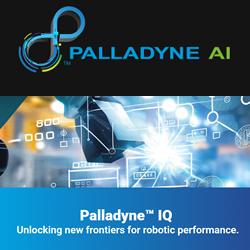Elevating Precision Motion and Control with Magnetic Levitation to New Heights
What sets magnetic levitation apart is the ability to create a contactless, ultra-high-precision virtual bearing within our control system". Dr. Christian Rudolf provides a glimpse into the exciting development journey of PI's magnetic levitation solutions.
Case Study: Delta Line Motion System Solutions for Robotics
Delta Line motors, particularly those in its rapidly expanding frameless range, offer exceptional power density and are well suited to meet the need for compact yet powerful motion solutions.
Drives for Speed in Intralogistics
Competitive intralogistics requires extensive automation, something that is inconceivable without micromotors. Drive systems from FAULHABER prove their ability to perform here during sorting, transporting and with robotics solutions.
The Importance of the Speed-Torque Gradient in DC Motor Sizing
The speed / torque gradient is an indicator of a motor's performance. The smaller the value, the more powerful the motor and consequently the less motor speed varies with load variations. It is based on the quotient of ideal no-load speed and ideal stall torque.
Understanding the Motor Constant in DC Motor Sizing
One of the most often overlooked parameters of direct current motors (both brush and brushless) is the Km or motor constant. The motor constant (expressed as Km) defines the ability of a motor to transform electrical power into mechanical power.
RoboticsTomorrow.com - Q&A with ElecroCraft
We provide motion control solutions in the form of electric motors, drives and motion control solutions for OEM Customers who are unsatisfied with having to design around inflexible off-the-shelf products.
Slotless Brushless Servo Motors Improve Machine Performance.
From the outside it looks just like any other industrial brushless servo motor but inside it utilized advanced manufacturing techniques to provide higher torque, higher speed, smoother operation, higher efficiency, and better inertial matching in a smaller package.
Power Density in Robotics
One of the basic requirements for the drives of mobile robots is high power density. For robots, this usually means high torque while taking up the smallest possible space.
Understanding Torque Ripple in Servo Motors
Torque ripple must be defined as a function of output load and speed. For load specification the most sensible rating point is the continuous duty thermal torque rating for the servo motor.
These Robots Crawl Into Every Nook and Cranny
The latest addition is a small crawler robot that magnetically "sticks" to metal walls and is able to move in all directions. It carries cameras, sensors and tools for inspection or maintenance work in tight pipes and on the outer hulls of tanks or ships.
Forms of Closed Loop Stepper Control
2017 - Most Popular Article - To achieve the highest performance, the stepper motor can be treated as a 2 phase brushless servo motor. Current to the motor will then be controlled as a function of the error signal just as with standard servo motors.
Encoder Selection: Speed Control
A general in depth analysis shows that the highest encoder resolutions are required for very precise speed control. The encoder resolution increases with the square of the demanded speed accuracy.
Development of Battery-Free Multi-Rotation Absolute Encoder
In recent years, there have been many demands for equipment with high productivity to have a system that retains positioning information, even after the main power supply is turned off.
Records 1 to 13 of 13
Featured Product

Palladyne IQ - Unlocking new frontiers for robotic performance.
Palladyne IQ is a closed-loop autonomy software that uses artificial intelligence (AI) and machine learning (ML) technologies to provide human-like reasoning capabilities for industrial robots and collaborative robots (cobots). By enabling robots to perceive variations or changes in the real-world environment and adapt to them dynamically, Palladyne IQ helps make robots smarter today and ready to handle jobs that have historically been too complex to automate.
Robotics and Automation - Featured Company

PI USA (Physik Instrumente)
PI is a privately held company that designs and manufactures world-class precision motion and automation systems including air bearings, hexapods and piezo drives at locations in North America, Europe, and Asia. The company was founded 5 decades ago and today employs more than 1700 people worldwide. PI's customers are leaders in high-tech industries and research institutes in fields such as photonics, life-sciences, semiconductors and aerospace.




.jpg)



.jpg)




